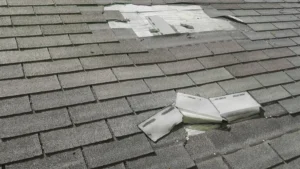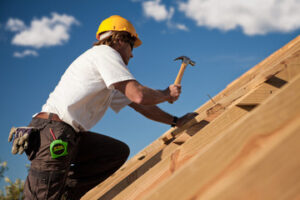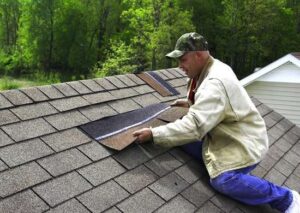Roofing Company King Of Prussia is the construction and installation of the uppermost portion of a building or structure. It protects against sunlight, rain, snow, and wind.
Tile roofs are made from raw materials that don’t deplete limited natural resources, and they have exceptional insulating properties, which reduce summer heat gain and winter energy costs.

Roll roofing is a mineral-surfaced roof product that comes in large rolls and is easy to obtain at home improvement stores. It is less expensive than shingles and can be installed relatively quickly. It can be used for small roof repairs or re-roofing projects.
It is usually composed of a fiberglass mat saturated with asphalt and coated with mineral granules. This offers a reasonable resistance to weather elements but may not be as durable as shingle roofing. It is commonly used for low-pitch roofs such as gazebos, sheds, and garages. It also works well for patios, three-season rooms, and other functional structures.
The main advantage of rolled roofing is that it is relatively easy to install and requires minimal tools. A homeowner can do it with some experience in roofing projects. This can save on labor costs and help to keep project expenses down. It can also be used for temporary structures such as site offices and storage sheds.
One drawback of rolled roofing is that it needs to have the aesthetic appeal of shingles, which can detract from the home’s overall look. In addition, rolled roofing is not considered a permanent roof and often doesn’t offer good resale value.
To ensure the longevity of a rolled roofing installation, it is important to prepare the roof surface carefully before the roofing begins. This should include removing any existing degraded material and ensuring the roof is clean, dry, and free from debris. A suitable underlayment should also be applied, which will help to prevent moisture penetration and improve the lifespan of the rolled roofing.
Once the underlayment and the roof deck are prepared, the first layer of rolled roofing can be installed. It should be positioned so that it overlaps the edges of the previous layer by at least 2 inches. This will prevent the roof from lifting in wind and storms.
After placing the first layer, the roofing should be nailed to the roof using a strong hammer at 10-inch intervals across the entire surface. Roofing cement can cover the nails and seal them in place. Once the nails have been covered, the edge of the rolled roofing should be lapped over and secured with roofing cement.
While wood isn’t the most popular roofing material today, it remains one of the best choices for homeowners looking to invest in a timeless aesthetic. A wood roof is a classic option that lasts 30-50 years with proper maintenance. It’s also one of the most cost-effective roofing materials. It’s easier to install and less costly than other shingles, such as slate or clay.
When choosing a wood roof, you’ll want to select a type of cedar that is naturally resistant to moisture and rot. Other wood varieties commonly used for shingles include yellow pine and cypress. However, these options are less durable than cedar and require additional chemical treatments to prevent insect infestation.
Whether you choose shake or shingle, your wood roofing will come in a hand-split, resawn, or taper-sawn look. Handsplit and resawn shakes offer a rustic appearance unique to each piece, while taper-sawn provides a more clean, streamlined look. Both shakes offer natural weather resistance and are available in various thicknesses.
Moisture can be an issue for wood roofs, especially if not treated. This is because it tends to swell and warp when wet, leading to leaks and water damage. If you’re concerned about this, ask your roofing contractor if the shakes or shingles are treated with moisture-resistant chemicals.
Another concern with wood is its flammability. This is why using a wood roof in areas with a high risk of wildfires is not recommended. Additionally, a wood roof requires more maintenance than other shingles, including regular applications of flame-retardant coatings. In addition, it’s less insulating than other roofing materials. As such, it can increase your energy bills. It’s also prone to mildew growth and fungus. If you’re considering a wood roof, contact a Roof Company for more information about your options. We can help you find the right fit for your home’s style and climate.
Metal roofs are the real deal for homeowners who want to keep their energy costs low, reduce maintenance, and protect the environment. They’re a good option for snowy climates because of their durability, effective weatherproofing, and fire resistance that asphalt shingles can’t match.
Most people think of a metal roof as the traditional corrugated panels they see on barns and farmhouses, but today’s metal roofing isn’t limited to that style. Today’s metal roofs can be manufactured to mimic shingles, clay tile or slate, and even wood shakes. It’s all done with multiple-layer factory finishes that ensure the look isn’t just beautiful, long-lasting, and durable.
A metal roof can be made from several different materials, including galvanized steel (also called corrugated galvanized steel) or aluminum. Zinc-coated steel is another common choice, as it’s easy to maintain and highly corrosion-resistant. Most of these roofs feature a color finish painted onto the metal panels before installation, so there are many options for homeowners who prefer to avoid the stark appearance of bare metal.
One of the biggest draws of a metal roof is its energy-efficient savings, as it can provide up to 40% less cooling costs than traditional asphalt shingles. It’s also recyclable, so it’s a green choice for homeowners who want to live more sustainably.
Some people are concerned that a metal roof will attract lightning, but they’re no longer more likely to attract a lightning bolt than any other roofing material. Additionally, unlike asphalt shingles, which can catch fire from hot temperatures, metal is not attracted to heat and doesn’t ignite when exposed to flames.
The drawback to a metal roof is that it can be prone to dents, which can happen from falling tree branches or large hailstorms. However, if you have a warranty, these issues can be resolved.
Another concern with metal is that the thickness of the panels can vary, which can affect its durability. The thickness of a panel is measured using a gauge; higher numbers mean that the panel is thicker and more durable, while lower numbers indicate a thinner panel. Some manufacturers use a low grade of steel to save on cost, which lowers the strength and could result in leaks.
The roof tiles themselves can be made from a wide variety of materials. They are usually shaped to resemble other tile types but can also be fashioned to resemble traditional shingles or wood shakes. Some of the most popular roofing tiles are made of clay but can also be made of concrete, metal, or other materials. Clay tiles are often associated with Mediterranean or Spanish architecture, but they come in various colors and styles that can complement any home style.
The heavy thermal mass of tile roofs helps to keep a building’s interior at a comfortable temperature throughout the day and night, cutting down on heating and cooling costs. They also have excellent wind resistance and can withstand high speeds, making them an ideal choice for regions with harsh weather conditions.
Aesthetics are also a major selling point of tile roofs. They add a classic beauty to any structure and can significantly increase a property’s value. Aesthetics aside, tile roofing is durable and can last for centuries.
Suppose a homeowner decides on a tile roof. In that case, they should work directly with a professional roofing contractor to ensure that the proper materials are used and will meet local building codes. There are several things that a roofer must consider when installing tile, including the appropriate underlayment and the location of vents, chimneys, and other obstructions. Tile roofs require a bit more maintenance than other roofing materials, such as regular cleaning and the addition of protective chemicals.
Roofing tiles can be damaged by walking on them, so hiring an experienced roofer who understands the nuances of working with this material is important. They must also use a ladder or scaffolding that has been evaluated for weight load and safety. Using equipment that is not rated for this purpose could lead to serious injury or death.
Tile roofs must be regularly cleaned, treated, and inspected to prevent moss growth and mildew buildup. They are also susceptible to fire, a significant concern in areas prone to wildfires. However, if the proper maintenance is done, a tile roof can last for decades and add to the aesthetic appeal of a home.







